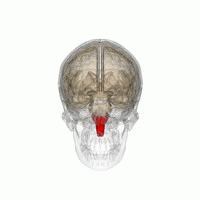Medulla oblongata (nonfiction): Difference between revisions
No edit summary |
|||
| Line 1: | Line 1: | ||
The '''medulla oblongata''' (or '''medulla''') is a cone-shaped neuronal mass in the | [[File:Medulla oblongata small.gif|frame|Medulla oblongata (animation).]]The '''medulla oblongata''' (or '''medulla''') is a cone-shaped neuronal mass in the brain. | ||
It is located in the hindbrain, anterior to the | It is located in the hindbrain, anterior to the cerebellum. | ||
== Function == | == Function == | ||
| Line 18: | Line 18: | ||
== Nonfiction cross-reference == | == Nonfiction cross-reference == | ||
== Fiction cross-reference == | == Fiction cross-reference == | ||
Revision as of 12:48, 28 May 2016
The medulla oblongata (or medulla) is a cone-shaped neuronal mass in the brain.
It is located in the hindbrain, anterior to the cerebellum.
Function
The medulla oblongata is responsible for multiple autonomic (involuntary) functions ranging from vomiting to sneezing.
The medulla contains the cardiac, respiratory, vomiting and vasomotor centers and therefore deals with the autonomic functions of breathing, heart rate and blood pressure.
Evolutionary history
Both lampreys and hagfish possess a fully developed medulla oblongata.
Since these are both very similar to early agnathans, it has been suggested that the medulla evolved in these early fish, approximately 505 million years ago.
The status of the medulla as part of the primordial reptilian brain is confirmed by its disproportionate size in modern reptiles such as the crocodile, alligator, and monitor lizard.
Nonfiction cross-reference
Fiction cross-reference
External links
- Medulla oblongata @ Wikipedia
